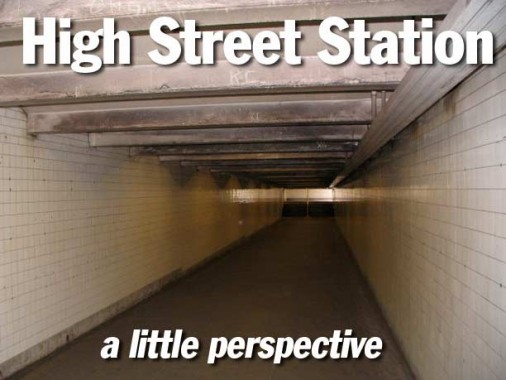If you’re unfamilar with the INDependent subway, IND stations are instantly recognizable in contrast to BMT and IRT stations, which were built earlier. In fact, I’m beginning to hear from people who no longer know the old subway divisions, which is understandable since the subways have, since 1940, been consolidated in the same system — which has had a number of names through the years, now the Metropolitan Transit Authority. Younger riders, except for train buffs, are now confused by the terms IRT, BMT, IND.
The 5-cent history is this: the first subway, which ran from City Hall to Broadway and 145th Street and opened in October 1904, was constructed by a company called Interborough Rapid Transit, even though the first route was Manhattan-only. Soon, lines were built into Brooklyn, justifying the name. Beginning in the 1910s, a company called Brooklyn Rapid Transit built a network of surface lines and subways between Brooklyn and Manhattan; when that company went bankrupt after a train crash in a tunnel at Malbone Street, Brooklyn, in 1918, it reorganized as Brooklyn-Manhattan Transit, or the BMT. Finally, in the mid-1920s, the City of New York began planning and building its own set of subway lines, called the Independent.
Despite consolidating in 1940 the three branches remain remarkably distinct. While the BMT and IND trains can run on each others’ lines since the cars are the same width and the platforms the same width, neither of those lines can run on IRT trackage, since its cars and platforms are narrower. At the same time, there are few points of exchange between what were the IND and BMT. One of them is a connection under Chrystie Street in Manhattan, idle for years but now used by the M train. When that connection was built [see Comments], it enabled both BMT and IND trains to run up 6th Avenue. There are no track connections between Manhattan/Brooklyn IRT trains and the other two divisions, although the Flushing IRT line has a track connection with the Astoria BMT line at Queensboro Plaza. The two lines were once run jointly by the BMT and IRT.
Within Bronx and Brooklyn trainyards, there are connections between the BMT and IRT [see Comments]
IND stations were built in cavernous fashion, apparently in reaction to the cramped quarters some IRT stations have to this day. This is somewhat inconvenient at times — getting to the platform sometimes takes so much time that you miss the train.
In early 2009 in Brooklyn Heights, I got a few pictures of the High Street station, typical of the IND local stations in Brooklyn.
Getting to the platform stairway takes awhile.
Finally there….
R-40 slant front cars have now been retired. They were introduced in the late 60s with bare slant ends, which were deemed dangerous for people passing between cars (now officially prohibited); gates were later installed. nycsubway.org
The IND’s tiled signage scheme has remained unchanged for the most part for the last 7 decades. In the 1930s, Fulton Street ran continuously from the East River to the Brooklyn-Queens line in Cypress Hills, but when in the 1950s, when Cadman Plaza, a large downtown park, was built, the portion of Fulton Street adjoining it was renamed Cadman Plaza West.
The High Street station was built deep underground. I wonder if an escalator was in place when the station was opened on February 11, 1933.
The station has exit/entrances on Fulton (Cadman Plaza West) and Cranberry, as well as Washington (Cadman Plaza East) and High (Red Cross Place). Downtown Brooklyn was a vastly different place when the IND opened here in 1933. Since then, entire blocks have given way to housing projects and expressways, and some streets remaining in place have been renamed. High Street, which used to run from Fulton Street east to Navy Street at the Brooklyn Navy Yard, was decimated and only two short stretches remain. A short piece between Washington and Adams was renamed Red Cross Place in the 1950s, as the Brooklyn headquarters of the worldwide relief agency was located there.
Thus, the High Street station is no longer on High Street.
The St. George Hotel was once one of the prime meeting spots in Brooklyn Heights, on Henry and Clark Streets. At one time the nation’s largest saltwater swimming pool as well as the world’s largest banquet hall were featured. The IRT 7th Avenue line are still entered from the hotel lobby. The St. George became a co-operative apartment complex after several years of decline in the 1990s.
Looks like a light in the distance.
The fresh and wholesome air of Brooklyn Heights, reattained.
3/22/12


